Jack Kirby did everything in comics, staying with comics in its darkest days and brightest nights. He covered every genre, including romance, which he co-invented. He developed new comics techniques like the Kirby krackle and the use of photo collage. He created a dynamism to characters that was later called the Marvel style.
Jack Kirby was self-taught and pugnacious. He probably would have never had a chance to get into a more established area of art. But he turned his weaknesses into strengths by developing his own style, techniques, and ideas.
He created a parable, elements of which can be seen throughout his career.
The first was superpowers. That may seem obvious in hindsight, but Kirby never included his parable in westerns, war, romance, or any other genre in which he worked. Since a major element of that parable is war between cultures, war and western comics would seem ideally suited to carry it.
Kirby realized it was stressful to get superpowers and the choices character is revealed by the choices made after getting superpowers. The first issue of Captain America shows Steve Rogers becoming the physically perfect person. Instantly he faces a choice of self preservation or attacking the Nazi spy who killed Dr Erskine. The character of Steve Rogers is revealed right away when he puts aside self preservation or grief and protects the greater good. That characterization hasn’t changed in seventy years.
On the other hand, when Spider-Man got superpowers he looked like he was going to be a supervillain. His concerns were personal and monetary. He resented his place in life. It was only the death of his uncle that led him to become a superhero.
The next element came in the 1950s. Jack Kirby did a series of stories with science fiction backgrounds and monsters as characters: Groot, Fin Fang Foom, Goom, Xemnu, Grottu, and others. Challengers of the Unknown added to the list of monsters. In these stories he drew fantastic creatures of immense power.
Then came the superhero resurgence. Kirby’s Challengers of the Unknown became a template for the Fantastic Four. He did the last of the monsters or maybe among the first of the superheroes when he drew the Hulk. He brought the monsters back memorably.
In the Fantastic Four, he created Galactus. Apart from looking human, he is one of Kirby’s science fiction monsters. Galactus has been rewritten as neither good nor evil but a force of nature. But consider that Kirby changed the character and used him again. In that new form, Kirby calls him Mantis, the energy vampire of Apokolips. Galactus, after all, takes the life force of worlds. Does anyone think Dracula should be rewritten as a morally neutral force of nature? Would Reed Richards argue that Dracula tests his victims, and if they survive they are proved worthy?
For both Kirby and Lee, Galactus and the Silver Surfer are evil and good unable to tolerate a relationship in which they are forced together. This became a major part of Kirby’s parable.
Kirby also drew the X-Men and that was the last piece he needed. The X-Men were good, their enemies, the Brotherhood of Evil Mutants, were evil. They get their super powers free, but they were still faced with the same choice, whether they become heroes or villains.
They are not simply another group with super powers, they have physical attributes most of which would be considered deformities. The Beast, the Toad, Iceman, and Mastermind all have deformities and it might have been part of the reason the X-Men didn’t sell well. By contrast, though the Angel is deformed, the associations with wings are positive. Totally against probability, neither Marvel Girl nor the Scarlet Witch is physically deformed. In fact, no female is deformed except Mystique, who obsesses about it.
Bimonth after bimonth the X-Men struggled against evil mutants. Initially, they did not face general supervillains like Dr Doom or the Red Skull. They faced Magneto, the Vanisher, Unus the Untouchable and the Blob.
Eleven super powered people with the same origin must have triggered something. Two years after the X-Men came the Inhumans. They were a society where everybody had a super power, some members of royalty (Blackbolt) had more than one. Many Inhumans were deformed by their super power. They even had Maximus, who had Magneto’s plot of wanting to replace humans with his own species.
At about the same time, Kirby was drawing the gods of Asgard. Like the Inhumans, everyone liked living in Asgardian socity except a small number of malcontents led by a chief malcontent, in this case, Loki. A few years later, Kirby was ready to ramp it up.
When he moved from Marvel to DC in 1970, Kirby thought he finally got a chance to take control of what he created. He created the Fourth World to have a beginning, a middle, and an end told in three streams: New Gods, Mr Miracle, and The Forever People. And he created one of the greatest villains in comic books: Darkseid. A composite of actor Jack Palance’s physical swagger and Richard Nixon’s lots of stuff, Darkseid has spent his entire fictional life searching for the Anti-Life Equation.
The New Gods famously open with the death of the Old Gods. It has generally been read politically, that the gods of Asgard were dead to him. Then again, what’s more dramatic than all the gods die and another pantheon arises?
There are two planets in the Fourth World saga, New Genesis and Apokolips. Everyone on those planets has super powers. In this sense, they are two cities of Asgard, two cities of Inhumans, or the planet X-Men and the Planet of Evil Mutants. In all cases, the leader is the most powerful and the greatest power is some kind of energy manipulation.
The denizens of Apokolips tend to be deformed. In some cases this deformity has grown, like with Desaad. Some, like Kalibak, are just kind of grizzly. That the deformity shows a moral deficiency is illustrated by Orion’s hidden face. The face we usually see is created for him by a Mother Box who rearranges his very atoms to make him presentable. However, Mother Box can’t make it permanent like any plastic surgeon could. Instead it is just a disguise, but what he looks like when the disguise is taken away varies.
Good versus evil is the basis of the parable, but then, it might be the basis of all of them. But in this case, it is the use and misuse of great power, or in this case, powers.
The parable begins in era of uneasy peace, kind of like the Cold War. The leaders have each sent his son to be raised by the other. New Genesis has taken in Darkseid’s son, Orion. Apokolips has taken in the son of the High Father, Scott Free aka Mr Miracle. New Genesis raises Orion as one of theirs. Apokolips tries to break Scott Free. It’s treaty style that is very old-style and even Middle Eastern first millennium BC. I think that was the era Kirby was thinking of. And in support of that I only have two words to say: Izaya and Isaiah.
Izaya is the Highfather and his name is clearly derived from Isaiah. Isaiah is a prophet of Judaism, Christianity, Islam, and Baha’i. Ignoring the arguments when the Book of Isaiah was written, it tells of the empires of Assyria and Babylon, their fall, and the restoration of Israel/Jerusalem. In this, read New Genesis as Israel/Jerusalem and Apokalips as the empires.
The Book also talks a great deal about the oppressed of empires, in particular the poor who are referred to as the hungry, the homeless, and the naked. It condemns the empires as being without justice. One section dealing with this is called the little Apocalypse. It talks of a city, an ultimate conflict in which a dragon is destroyed and the oppressors are punished.
Other parallels can be drawn with other elements of Jewish experience. The Source Wall is like the wall in Babylon on which there is writing (hence the expression the writing is on the wall), the Wall of Souls since those who try to get through it are captured by it and their images become part of its surface, and the Wailing Wall which is the only part of the second temple still standing.
He mixed these images and used them to replace that old divider between dimensions of ‘vibratory rates.’
This does show that the breadth of inspirations of Kirby’s Fourth World were very broad. Elements were layered on top of each other.
If Kirby had done this as a literary novel, people would have noticed that Orion uses his real name while Scott Free was just an appellation to make him part of the group at the orphanage where he grew up and Mr Miracle was just a name he took from an older dead man. New Genesis gives reality, Apokalips gives masks. Free needs to find his identity in escaping from Apokolips. But as it’s a comic book, no one bothers with a literary interpretation.
Don’t underestimate Kirby.
Darkseid works to find the Anti-Life Equation. When Darkseid knows it he will be able to take away the free will of all others. I once said Kirby didn’t like dictatorships, whether they were Nazi or Communist. But I don’t think he liked empires or any stripe in any time period. It seems he didn’t like empires and their conformity, the constant need to control what people see and think, and the way they always seem to stack deals in favor of a ruling clique. That describes of Apokolips.
The Fourth World comics did not sell well. I think the Fourth World was overlooked at the time because the payoff was too far away and the tone varied too much from title to title. The odds of someone liking the hippie road story Forever People, the war drama of The New Gods, and the superhero sensibilities of Mr Miracle were remote.
So the titles were canceled. But they could not be forgotten. The characters and unfinished story arcs could not be left alone. They have entered the DC Universe, they have been revived. People have tried to complete the story but it has become trapped in the eternal second act in which superhero stories tend to exist.
Kirby himself went back to Marvel where he continued the story. Again, there are two societies where everyone had super powers. Instead of new gods, these were inspired by old gods. Instead of the leader Zeus, there was the leader Zuras. Instead of the speedster Mercury, there was the speedster Makarri. The Eternals lived in Olympia, not on Olympus. But somehow the Greek deities and their Eternal parallels are said to have never met and never heard of each other, which is hard to believe.
The Eternals are handsome and good, the Deviants are deformed and evil. It is the same pattern as New Genesis and Apokalips, a descendant of the society of the X-Men. Since Kirby left the series, choice creating form has been completely abandoned and each species is benefited by or suffers from the effects of their ancestors’ creation.
Instead of the Sourcewall, there are the Celestials. They are the creators of both the Eternals and the Deviants. They will judge both though one would think their judgment is a foregone conclusion. But from what we see of them, they might as well be a wall. They don’t really move.
The Deviants are deformed, and the nature of a parent does not pass on to a child. Skin color, whether they have arms or tentacles, size and number of teeth, body shape, and so on. Where Apokalips has denizens who pass for human, the Deviants have no one to do that.
Eternals can combine to form the Uni-mind. The Deviants can not. The Forever People can combine to form (or release) the Infinity Man. Why do they give their minds when what Darkseid wants is the Anti-Life Equation which would take away free will? I think the parallel is deliberate and is part of the parable as a whole. The Uni-mind is voluntary and temporary. It is people as individuals working together. But the ultimate struggle of Uni-mind and Anti-Life in whatever form they take in one story will never be presented.
But Kirby did tell one more part of the tale. He went to Pacific Comics where they let him keep ownership of his characters. Kirby created Captain Victory.
Captain Victory is Captain of the Tiger, a kind of dreadnaught starship. If he gets killed another clone body is taken and he is revived. This is the New Gods trick of someone else taking over a role like with Black Racer, just extended infinitely and more narrowly. Captain Victory’s father had Orion’s equipment: it’s shown in the back of the panel. His grandfather, is only ever seen in shadow, and he is called Blackmass, but the shadow is in the shape of Darkseid. But once again Kirby never got to finish his story.
But the interesting thing is Captain Victory’s uniform. It’s red, white, and blue. It has a blue shirt, trunks and boots, and red gloves and leggings. It has a collar. It’s the uniform of The Kid, from Bucky to Rick Jones. Did Kirby plan to put The Kid into his story of “other”? We’ll never know. It’s an incomplete parable. It was probably planned to end with the fall of empires and the punishment of oppressors. And in the end that is the secret of the most important influence that went into the creation of the parable.
It was the parable of Kirby’s life, struggling against empires. As comics became successful and left the dark days behind and entered the bright nights. They demanded conformity from him and Kirby never liked that. What he wanted was collaboration: a Uni-mind that came, created, and split apart with each person regaining their autonomy. He didn’t like the attempt to revive Captain America in the fifties. Kirby’s incomplete parable is a call for an artist’s freedom and as such even its failure to be completed becomes part of the parable for all time.

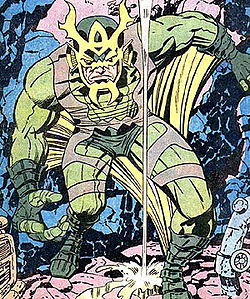
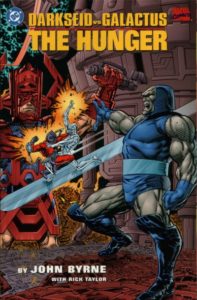

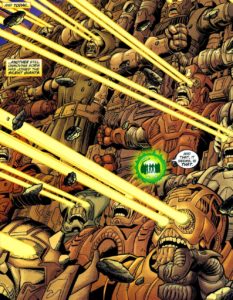
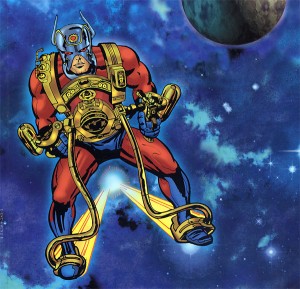
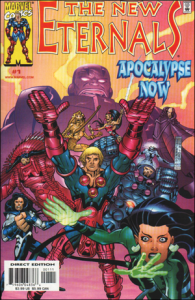
Comments are closed.